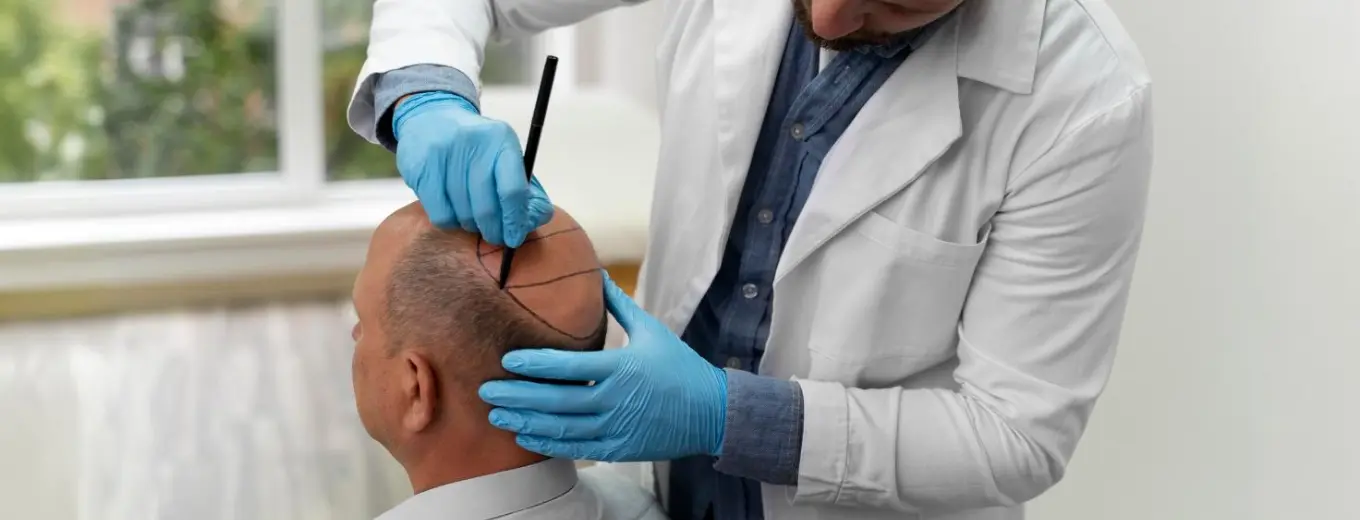“Doctor, I’ve noticed my hair thinning… Is it too late to fix it?”
You’re not alone—and no, it’s not too late. Hair loss is a common concern affecting both men and women, and it can feel overwhelming. Thankfully, with advancements in dermatology, hair transplant in Chennai has become a safe, effective, and long-lasting solution to restore not just your hair—but also your confidence.
At Ray & Rio’s Speciality Clinic, our goal is to offer personalized solutions that work. Whether you live near our facility offering hair transplant in Egmore or you’re looking for hair transplant in Neelankarai, this guide will walk you through everything you need to know—step by step.
Understanding Androgenetic Alopecia – The Root Cause
The most common type of hair loss is Androgenetic Alopecia—a genetic and hormonal condition that leads to patterned hair thinning.
- In men: It often starts at the temples and crown, creating an “M” shape.
- In women: It presents as overall thinning, especially around the parting line.
Early-stage patients often try topical solutions like Minoxidil or oral medications like Finasteride. But in more advanced cases, these treatments may not deliver satisfactory results. That’s when people turn to hair transplant in Chennai for a permanent solution.
Both our hair transplant in Egmore and hair transplant in Neelankarai clinics frequently help patients dealing with hereditary hair loss make informed treatment choices.
Am I a Good Candidate for Hair Transplant?
Not everyone needs surgery right away—but for some, it’s the best option. You’re an ideal candidate for hair transplant in Chennai if:
- Your hair loss has stabilized (not rapidly progressing).
- You have healthy donor hair (typically from the back or sides of your head).
- You’re in good general health.
- You have realistic expectations.
At Ray & Rio’s, patients seeking hair transplant in Egmore often benefit from our comprehensive consultations, while those at hair transplant in Neelankarai appreciate the calm, private setting for evaluation and planning.
What Happens Before the Procedure?
Before undergoing hair transplant in Chennai, our team conducts:
- A full medical history review.
- Scalp and hair density analysis.
- Blood tests to rule out complications.
- A detailed discussion of your goals and expected outcomes.
Patients at our hair transplant in Egmore location love our thorough approach, while hair transplant in Neelankarai patients value our blend of clinical accuracy and warm patient care.
FUE – The Modern Hair Transplant Method
The most preferred technique today is FUE (Follicular Unit Extraction). At Ray & Rio’s, we perform hair transplant in Chennai using FUE (Follicular unit extraction) because it’s precise, minimally invasive, and produces natural results.
Here’s how it works:
- Step 1: Local anesthesia is given to numb your scalp.
- Step 2: Healthy hair follicles are extracted from the donor area.
- Step 3: Micro-incisions are made in the bald or thinning areas.
- Step 4: Follicles are individually implanted into the recipient sites.
Patients at our hair transplant in Egmore clinic appreciate the advanced magnification tools we use, ensuring follicle safety. Meanwhile, the hair transplant in Neelankarai branch offers a peaceful environment that supports a smooth recovery experience.
Aftercare & Recovery: What to Expect Post-Surgery
“Doctor, will I need to take leave from work?”
Recovery after hair transplant in Chennai is straightforward:
- Mild swelling or scabbing may occur for a few days.
- Avoid touching the transplanted area.
- Use only prescribed shampoos and medications.
- Avoid gym workouts or direct sunlight for 7–10 days.
Patients from hair transplant in Egmore usually resume light duties within 2–3 days. For patients opting for hair transplant in Neelankarai, we provide complete post-op support with easy follow-ups and guidance.
You’ll start seeing new growth by the third or fourth month. Full results are visible within 6–12 months—and they’re usually permanent.
Can PRP Boost Results After Hair Transplant?
Yes, and we recommend it. PRP (Platelet-Rich Plasma) therapy is a natural, non-surgical treatment using your blood’s own healing factors. When combined with hair transplant in Chennai, PRP helps:
- Accelerate healing
- Improve graft survival
- Stimulate thicker regrowth
Patients at both hair transplant in Egmore and hair transplant in Neelankarai often include PRP in their treatment plans for enhanced outcomes.
Why Choose Ray & Rio’s for Hair Transplant in Chennai?
You’re not just getting a procedure—you’re getting a personalized experience. Here’s why patients trust us:
- Expertise: Led by Dr. Annie Flora, a dermatologist skilled in hair restoration.
- Safety: Clean, advanced surgical setups for every hair transplant in Chennai.
- Customization: Every case is unique, and so is our approach.
- Technology: We use high-resolution magnification and premium-quality instruments.
- Comfort: Whether you choose hair transplant in Egmore or hair transplant in Neelankarai, our facilities are designed for ease, privacy, and comfort.
Final Thoughts: Ready for Your Transformation?
Hair loss isn’t just cosmetic—it affects how you feel every day. If you’re seeing visible thinning or bald patches, don’t wait. Hair transplant in Chennai can give you the natural, full hair you’ve been missing.
Patients from hair transplant in Egmore and hair transplant in Neelankarai have already taken this step—and experienced a renewed sense of confidence.
You deserve to feel good about your reflection. Let Ray & Rio’s Speciality Clinic help you get there—with science, skill, and sincere care.

